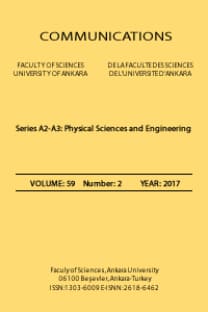COMPUTATIONAL BIFURCATION ANALYSIS TO FIND DYNAMIC TRANSITIONS OF THE CORTICOTROPH MODEL
Dynamical System, Bifurcation analysis, Corticotroph Model, Bursting Oscillations, Spiking oscillations
___
Hodgkin, A. L., Huxley, A. F., “A quantitative description of membrane current and its application to conduction and excitation in nerve”, Journal of Physiology, 117(4) (1952) 500–544.[Duncan, P. J., Sengul, S., Tabak, J., Ruth, P., Bertram, R., Shipston, M. J., “Large conductance Ca2+-activated K+ channels (BK) promote secretagogue-induced transition from spiking to bursting in murine anterior pituitary corticotrophs”, Journal of Physiology, 593(5) (2015) 1197–1211.
Murphy, H., Jaafari, H., Dobrovolny, H. M., “Differences in predictions of ODE models of tumor growth: a cautionary example”, BMC Cancer, 16 (2016) 163.
Mary Celin Sharmila, D., Praveen, T., Rajendran, L., “Mathematical Modeling and Analysis of Nonlinear Enzyme Catalyzed Reaction Processes”, Journal of Theoretical Chemistry, (2013) 2013:7.
Schaff, J. C., Gao, F., Li, Y., Novak, I. L., Slepchenko, B. M., “Numerical Approach to Spatial Deterministic-Stochastic Models Arising in Cell Biology”, PLoS Comput Biol., 12(12) (2016) e1005236.
Rinzel, J., A Formal Classification of Bursting Mechanisms in Excitable Systems, Springer Berlin Heidelberg, 1987.
Sherman, A., “Dynamical systems theory in physiology”, The Journal of General Physiology, 138(1) (2011) 13–19.
Strogatz, S. H., Nonlinear Dynamics and Chaos, Addison-Wesley Publishing Company, 2001.
Morris, C., Lecar, H., “Voltage oscillations in the barnacle giant muscle fiber”, Biophys J., 35(1) (1981) 193–213.
Plant, R. E., Kim, M., “Mathematical descriptions of a bursting pacemaker neuron by a modification of the Hodgkin-Huxley equations”, Biophys. J., 16(3) (1976) 227–244.
Braun, H. A., Bade, H., Hensel, H., “Static and dynamic discharge patterns of bursting cold fibers related to hypothetical receptor mechanisms”, Pflügers Arch., 386(1) (1980) 1–9.
Clewley, R. H., Sherwood, W. E., Lamar, M. D., Guckenheimer, J. M., “PyDSTool, a software environment for dynamical systems modeling, URL=http://pydstool.sourceforge.net”, (2007).
Atherton, L. A., Prince, L. Y., Tsaneva-Atanasova, K., “Bifurcation analysis of a two-compartment hippocampal pyramidal cell model”, J Comput Neuroscience, 41 (2016) 91–106.
Ananthkrishnan, N., Gupta, N. K., Sinha, N. K., “Computational Bifurcation Analysis of Multiparameter Dynamical Systems”, Journal of Guidance Control and Dynamics, 32(5) (2009) 1651-1653.
Tsaneva-Atanasova, K., Osinga, H. M., Rieb, T., Sherman, A., “Full System Bifurcation Analysis of Endocrine Bursting Models”, J Theor Biol., 264(4) (2010) 1133–1146.
Čupić, Z., Marković, V. M., Maćešić, S., Stanojević, A., Damjanović, S., Vukojević, V., Kolar-Anić, L., “Dynamic transitions in a model of the hypothalamic-pituitary-adrenal axis”, Chaos, 26(3) (2016) 033111.
Takahashi, A., Kitajima H., Yazawa, T., “Bifurcation Analysis for Early Afterdepolarization in Shannon Model”, International Symposium on Nonlinear Theory and Its Applications, NOLTA2016, Yugawara, Japan, (2016).
Tabak, J., Tomaiuolo, M., Gonzalez-Iglesias, A. E., Milescu, L. S., Bertram, R., “Fast activating voltage- and calcium-dependent potassium (BK) conductance promotes bursting in pituitary cells: a dynamic clamp study”, J Neurosci, 31(46) (2011) 16855–16863.
Mrejeru, A., Wei, A., Ramirez, J. M., “Calcium-activated non-selective cation currents are involved in generation of tonic and bursting activity in dopamine neurons of the substantia nigra pars compacta”, J Physiol, 589(Pt 10): (2011) 2497–2514.
Partridge, L. D., Müller, T. H., Swandulla, D., “Calcium-activated non-selective channels in the nervous system”, Brain Research Reviews, 19(3) (1994) 319-325.
Sankaranarayanan, S., Simasko, S. M., “Potassium channel blockers have minimal effect on repolarization of spontaneous action potentials in rat pituitary lactotropes”, Neuroendocrinology, 68 (1998) 297–311.
Charles, A. C., Piros, E. T., Evans, C. J., Hales, T. G., “L-type Ca2+ channels and K+ channels specifically modulate the frequency and amplitude of spontaneous Ca2+ oscillations and have distinct roles in prolactin release in GH3 cells”, J Biol Chem., 274(11) (1999) 7508–7515.
Mei, Y. A., Soriani, O., Castel, H., Vaudry, H., Cazin, L., “Adenosine potentiates the delayed-rectifier potassium conductance but has no effect on the hyperpolarization-activated Ih current in frog melanotrophs”, Brain Res, 793(1-2) (1998) 271–278.
Song, Z., Xu, J., “Bursting near bautin bifurcation in a neural network with delay coupling”, Int. J. Neur. Syst., 19(5) (2009) 359-373.
Stojilkovic, S. S., “Pituitary cell type-specific electrical activity, calcium signaling and secretion”, Biol Res., 39(3) (2006) 403-423.
Jia, B., Gu, H., Li, L., Zhao, X., “Dynamics of period-doubling bifurcation to chaos in the spontaneous neural firing patterns”, Cogn Neurodyn, 6(1) (2012) 89-106.
Zemkova, H., Tomić, M., Kucka, M., Aguilera, G.,Stojilkovic, S.S., “Spontaneous and CRH-induced excitability and calcium signaling in mice corticotrophs involves sodium, calcium, and cation-conducting channels”, Endocrinology, 157(4) (2016) 1576–1589.
Shipston, M., “Control of anterior pituitary cell excitability by calcium-activated potassium channels”, Mol Cell Endocrinol., 463 (2018) 37-48.
- ISSN: 1303-6009
- Yayın Aralığı: Yılda 2 Sayı
- Başlangıç: 2019
- Yayıncı: Ankara Üniversitesi
CRIME PREDICTION USING SOCIAL SENTIMENT AND SOCIO-FACTOR
Sakirin TAM, Ö. Özgür TANRIÖVER
CONTROL OF COLLECTIVE BURSTING IN SMALL HODGKIN-HUXLEY NEURON CLUSTERS
Sergey BORISENOK, Önder ÇATMABACAK, Zeynep ÜNAL
CELL OUTAGE DETECTION IN LTE-A CELLULAR SYSTEMS USING NEURAL NETWORKS
Hasan Tahsin OĞUZ, Aykut KALAYCIOĞLU
COMPUTATIONAL BIFURCATION ANALYSIS TO FIND DYNAMIC TRANSITIONS OF THE CORTICOTROPH MODEL
Entropy exchange and entanglement in the Jaynes-Cummings model with transient effects
